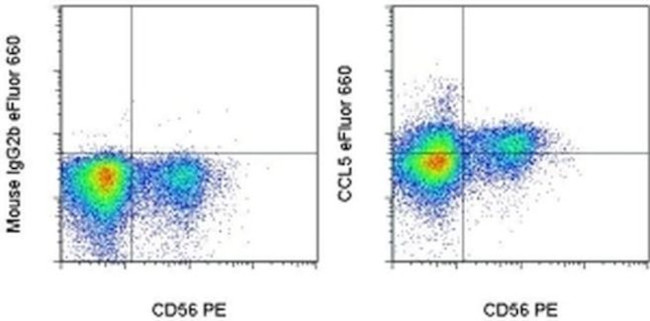Search Thermo Fisher Scientific
Invitrogen
CCL5 (RANTES) Monoclonal Antibody (VL1), eFluor™ 660, eBioscience™
FIGURE: 1 / 1
CCL5 (RANTES) Antibody (50-9905-42) in Flow

Product Details
50-9905-42
Species Reactivity
Host/Isotype
Recommended Isotype Control
Class
Type
Clone
Conjugate
Excitation/Emission Max
Form
Concentration
Purification
Storage buffer
Contains
Storage conditions
Shipping conditions
RRID
Product Specific Information
Description: The VL1 monoclonal antibody reacts with human CCL5/RANTES (Regulated upon Activation, Normal T cell Expressed and Secreted). RANTES is an 8 kDa member of the C-C chemokine family. Although rapidly induced in fibroblasts and epithelial cells, RANTES is upregulated only after 3-5 days of activation in T cells. As with other members of the C-C chemokine family, RANTES is a strong chemotractant for monocytes, NK cells, eosinophils and T cells. RANTES is also expressed by monocytes upon activation and has recently been reported to be constitutively expressed by NK cells.
Applications Reported: This VL1 antibody has been reported for use in intracellular staining followed by flow cytometric analysis.
Applications Tested: This VL1 antibody has been pre-titrated and tested by intracellular staining and flow cytometric analysis of stimulated normal human peripheral blood cells. This can be used at 5 µL (0.25 µg) per test. A test is defined as the amount (µg) of antibody that will stain a cell sample in a final volume of 100 µL. Cell number should be determined empirically but can range from 10^5 to 10^8 cells/test.
eFluor® 660 is a replacement for Alexa Fluor® 647. eFluor® 660 emits at 659 nm and is excited with the red laser (633 nm). Please make sure that your instrument is capable of detecting this fluorochome.
Excitation: 633-647 nm; Emission: 668 nm; Laser: Red Laser.
Filtration: 0.2 µm post-manufacturing filtered.
Target Information
CCL5 (RANTES) is a chemokine gene located on the q-arm of chromosome 17. Chemokines are a superfamily of secreted proteins involved in immunoregulatory and inflammatory processes. The superfamily is divided into four subfamilies based on the arrangement of the N-terminal cysteine residues of the mature peptide. CCL5, a member of the CC subfamily, functions as a chemoattractant for blood monocytes, memory T helper cells, and eosinophils. It causes the release of histamine from basophils and activates eosinophils. This cytokine is one of the major HIV-suppressive factors produced by CD8+ cells. It functions as one of the natural ligands for the chemokine receptor chemokine (C-C motif) receptor 5 (CCR5), and it suppresses in vitro replication of the R5 strains of HIV-1, which use CCR5 as a coreceptor. Alternative splicing results in multiple transcript variants that encode different isoforms. Diseases associated with CCL5 include Human Immunodeficiency Virus Type 1 and Periapical Granuloma.
For Research Use Only. Not for use in diagnostic procedures. Not for resale without express authorization.
How to use the Panel Builder
Watch the video to learn how to use the Invitrogen Flow Cytometry Panel Builder to build your next flow cytometry panel in 5 easy steps.
References (0)
Bioinformatics
Protein Aliases: beta-chemokine RANTES; C-C motif chemokine 5; chemokine (C-C motif) ligand 5; EoCP; Eosinophil chemotactic cytokine; MGC17164; OTTHUMP00000197106; regulated upon activation, normally T-expressed, and presumably secreted; SIS δ; SIS-delta; SISδ; small inducible cytokine subfamily A (Cys-Cys), member 5; Small-inducible cytokine A5; T cell-specific protein P228; T-cell specific protein p288; T-cell-specific protein RANTES; TCP228
Gene Aliases: CCL5; D17S136E; eoCP; RANTES; SCYA5; SIS-delta; SISd; TCP228
UniProt ID: (Human) P13501
Entrez Gene ID: (Human) 6352

Performance Guarantee
If an Invitrogen™ antibody doesn't perform as described on our website or datasheet,we'll replace the product at no cost to you, or provide you with a credit for a future purchase.*
Learn more
We're here to help
Get expert recommendations for common problems or connect directly with an on staff expert for technical assistance related to applications, equipment and general product use.
Contact tech support

